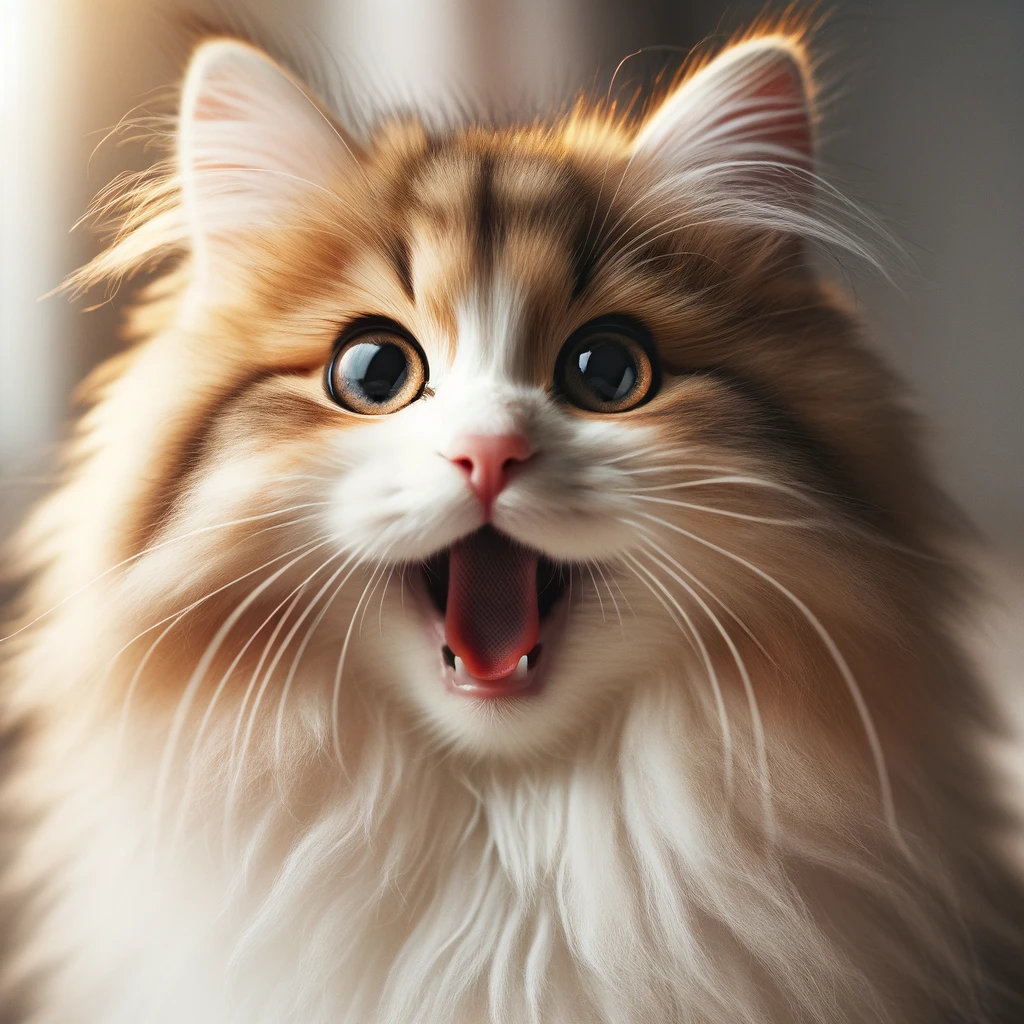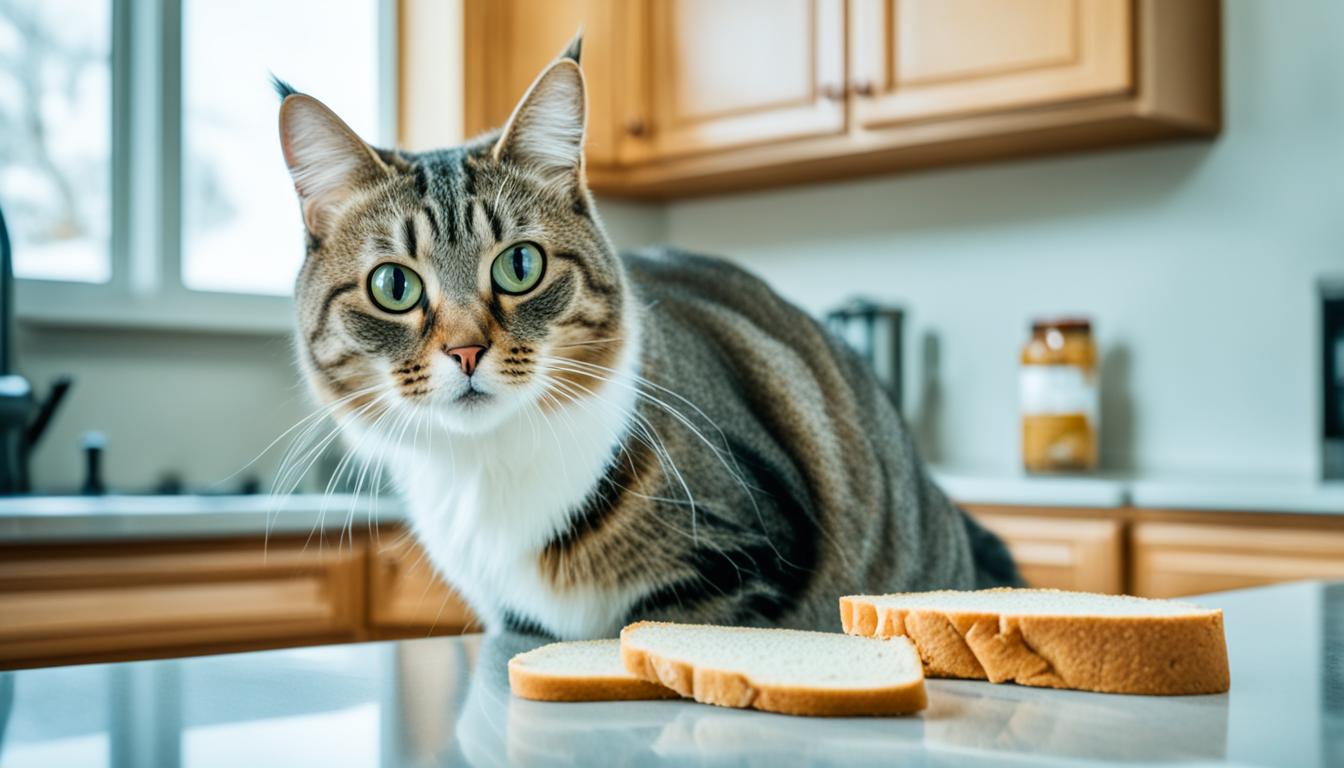As an Amazon Associate I earn from qualifying purchases.
Wondering if you can give your morning toast to your cat is natural for a pet owner. Although bread might look safe, it’s important to look at what it could do if your cat eats it.
Bread is not harmful, but it doesn’t have what cats need to be healthy. It’s full of calories and carbs, but has little protein. Without enough protein, a cat’s diet is not balanced. Too much bread can make your cat gain weight and have stomach problems because they can’t process carbs well.
It’s also crucial to avoid giving your cats raw dough. The warm and wet space in their stomach makes the dough keep growing. This can cause a very serious issue called bloat. Also, the yeast in dough creates dangerous gases and alcohol, which are bad for cat’s health.
Key Takeaways
- Bread lacks essential nutrients required for a balanced cat food diet.
- Excessive bread consumption can contribute to weight gain and digestive issues in cats.
- Raw bread dough is highly dangerous, as it can cause bloating and ethanol production in a cat’s digestive system.
- It’s best to provide cats with a complete and balanced feline nutrition plan, tailored to their specific dietary requirements.
- Consult with a veterinarian for personalized feeding guidelines and advice on introducing occasional treats responsibly.
Understanding Feline Nutrition
For cat owners, knowing what cats need to eat is key for their health. Cats are different from us or dogs. They need lots of protein, some fat, and not much carbs. This matches their natural diet of hunting. It’s good for their body and helps them digest their food well.
Cats’ Dietary Requirements
Cats need a special diet to be their best. Their meals should have lots of animal protein. They also need fat but just a bit of carbs. This diet matches their body’s needs and their natural hunting ways.
Role of Protein in a Cat’s Diet
Protein is very important for cats. It helps their muscles grow, repairs their body, and makes enzymes. Cats eat more protein than other animals. Their bodies are great at turning protein into energy and keeping them healthy.
Importance of a Complete and Balanced Diet
Making sure your cat eats right is crucial. A good cat food has the perfect mix of protein, fats, carbs, vitamins, and minerals. This meets all your cat’s nutritional needs.
Prescription Diet and Science Diet are good brands for your cat’s food. They make food for kittens to seniors, which meets their changing needs. A balanced diet helps your cat grow well, stay at a good weight, and avoid health problems.
| Life Stage | Protein Requirement | Calorie Requirement |
|---|---|---|
| Kitten | 30% of total calories | 200-300 kcal/kg body weight |
| Adult (1-6 years) | 26% of total calories | 60-80 kcal/kg body weight |
| Adult (7+ years) | 28% of total calories | 50-70 kcal/kg body weight |
Understanding protein and a balanced diet is important. It helps you choose what’s best for your cat. This way, your cat will be healthier and happier.
Bread: A Closer Look
Bread is a common food found in many homes. Did you know that cats can also eat bread? However, it’s crucial to know about its nutrition and types before sharing with your cat.
Nutritional Value of Bread
Bread is rich in carbohydrates. Its main ingredients are grains, water, and yeast. It gives energy and some B vitamins but lacks the vital nutrients cats need like high-quality protein, fats, and specific vitamins and minerals. Thus, bread is best as a rare treat for cats, not a daily meal.
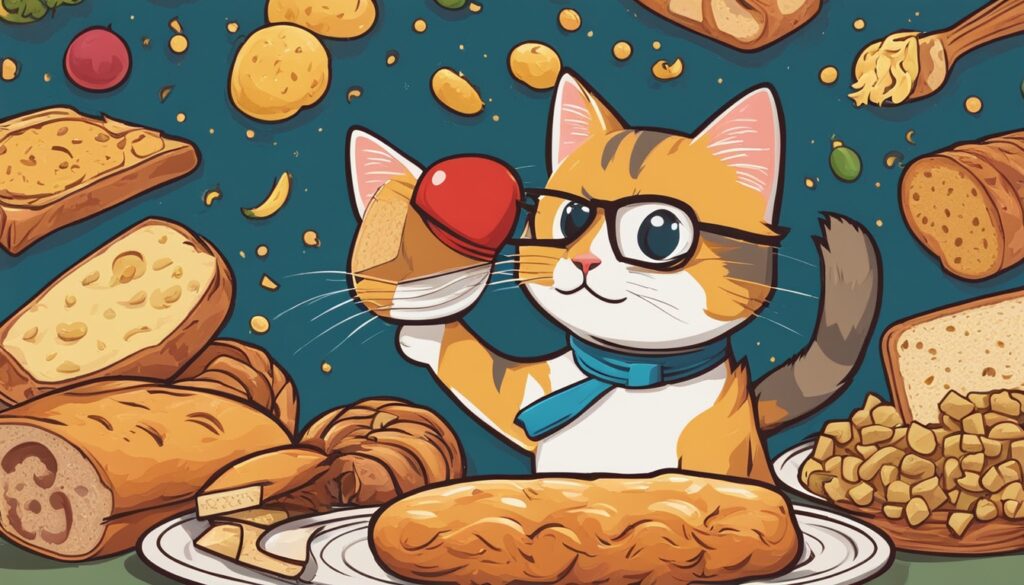
Types of Bread and Their Ingredients
There are many bread types, each with different ingredients and nutrition values. White bread is from refined grains and has less nutrition than whole wheat bread, made from whole grains and richer in fiber. Sourdough bread, made through fermentation, can be gentler on cats’ stomachs.
Be aware that some breads have additives like preservatives or sweeteners. These could harm your cat if eaten too much. Avoid breads with nuts, garlic, onions, or other known cat toxins.
If you choose to give bread to your cat, pick simple kinds. Look for bread that’s plain, without added sugars or fats. This choice lowers the chance of your cat having stomach issues or getting sick.
Can Cats Eat Bread?
Cats can eat small amounts of plain bread. However, it’s not good for them regularly. Bread doesn’t offer what cats need nutrition-wise. Plus, if they eat too much, it might lead to problems like being overweight or digestive trouble.
Cats must mainly eat animal proteins because they are carnivores. Giving them bread as a rare treat won’t do much harm. But, it’s better not to give cats bread as part of their usual meals.
Responsible pet owners should prioritize providing their feline companions with a complete and balanced diet specifically formulated to meet their unique nutritional needs.
Hill’s Pet Nutrition is a top brand in pet food, offering different options for cats’ needs such as:
- Kitten
- Adult (1-6 years)
- Adult (7+ years)
It’s important for cat owners to seek advice from vets. They should also follow guidelines to keep their pets healthy through their diet.
Potential Risks of Feeding Bread to Cats
Bread might seem safe, but it’s crucial to know the dangers of giving it to your cat. Bread doesn’t offer what cats need in their diet and has a lot of carbs. This can cause health problems for your cat.
Lack of Nutritional Benefits
Cats are obligate carnivores. They need meat and fat for nutrition. Bread just has empty calories. So, it doesn’t help meet a cat’s real dietary requirements.
High Calorie and Carbohydrate Content
Bread is full of carbs and calories. Eating too much can make a cat overweight. This can lead to serious health issues like diabetes and joint pain. Cats can’t process carbs well, so bread isn’t good for them.
Potential for Digestive Issues
Cats can’t easily digest carbs from bread. Too much bread can upset their stomach. This might cause them to throw up, have diarrhea, or get constipated. Some cats find bread too heavy to digest.
| Bread Type | Potential Risks |
|---|---|
| White Bread | Considered one of the safer options due to fewer harmful ingredients, but still lacks essential nutrients for feline nutrition. |
| Wheat Bread | Most brands lack harmful additives, but the high carbohydrate content can lead to weight gain and digestive issues if consumed excessively. |
| Banana Bread | Added sugar and spices decrease nutritional benefits and increase the risk of toxicity for cats. |
| Garlic Bread | Garlic is toxic to cats, even in small quantities from garlic butter, posing a significant bread safety concern. |
So, giving your cat a small piece of plain bread once in a while won’t hurt. But, be careful with any human food you offer. Always put your cat’s health first with a diet that meets their needs.
Dangers of Raw Bread Dough for Cats
While cooked bread in moderation is okay for cats, raw dough is dangerous. It can harm their health and should not be given to them. The key problems with raw dough are bloating, a swollen stomach, and the production of ethanol from yeast.
Bloating and Distended Stomach
A cat’s warm, moist stomach is a great place for raw bread dough to rise more. The fermenting dough makes carbon dioxide. This causes the stomach to bloat and swell. It poses serious health risks to cats, including discomfort and potentially deadly bloat.
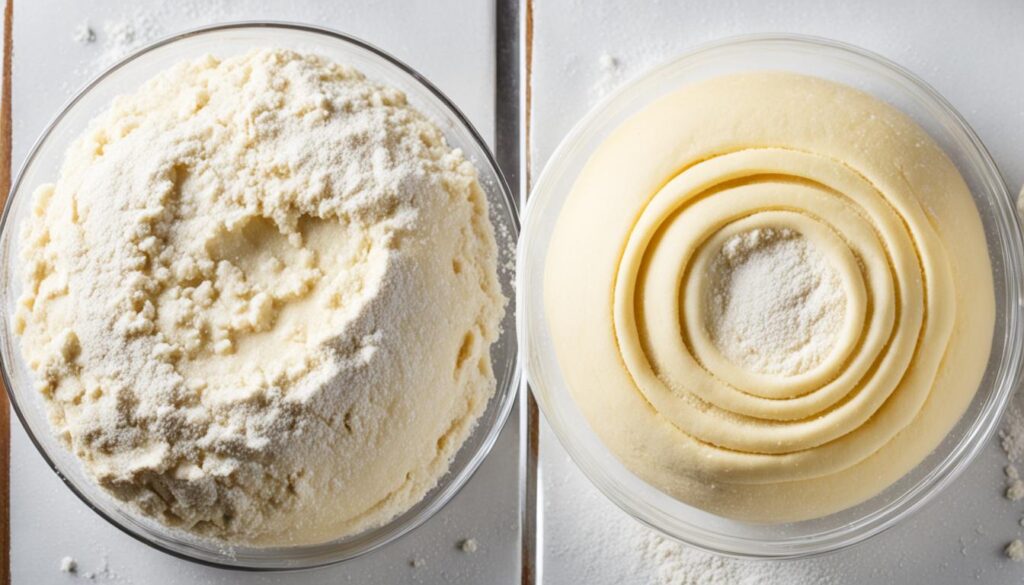
Ethanol Production from Yeast
The problem with raw dough doesn’t stop at bloating. The yeast in raw dough turns into ethanol, which is alcohol. This alcohol is toxic to cats. Even a little bit can make them sick, causing vomiting, diarrhea, and confusion. Large amounts are even more dangerous. Cats’ bodies can’t handle ethanol well, making it harmful to them.
Keeping your cat away from raw dough is the best way to protect them. If your cat might have eaten some, it’s critical to act fast. Contact your vet immediately. With quick treatment, the dangers can hopefully be avoided.
Toppings and Additives to Avoid
An occasional, plain piece of bread is okay for cats to eat. But, it’s important to skip any extras on the bread. These could be bad for your cat’s pet health. Cats need a special diet. Some bread ingredients can hurt them.
Butter and High-Fat Spreads
Avoid butter and fat-rich spreads like peanut butter with bread for your cat. These are full of fats and calories. They can make your cat overweight or cause pancreatitis. Cats must eat foods low in carbs and rich in protein from meat.
Chocolate and Its Toxicity
Chocolate is very harmful to cats and should never be given. It contains theobromine and caffeine, which are toxic. Eating it can cause stomach issues, hyperactivity, and heart problems in severe cases.
Treats should account for no more than five to 10 percent of a cat’s daily caloric intake.
While a bit of bread every now and then seems fine for cats, don’t swap it for their regular diet. A diet designed for your cat’s health is crucial. Bread for cats needs careful handling. Too much or the wrong toppings can harm your cat.
| Safe for Cats | Not Safe for Cats |
|---|---|
| Small, bite-sized piece of plain bread (1/4-inch square) | Butter or high-fat spreads |
| Occasional treat (no more than 10% of daily calorie intake) | Chocolate (contains theobromine and caffeine) |
| Plain gluten-free baked bread (once or twice a week) | Bread toppings or additives |
It’s key to know what bread toppings and additives can hurt your cat. This helps you keep your cat safe and healthy.
Alternatives to Bread for Cats
Sharing bread with your cat might seem nice, but it’s not the best for them. Bread doesn’t offer much nutrition for cats. It could even be bad for their health. Instead, give your cat treats and snacks that are made for them.
Cat Treats and Snacks
Brands like Hill’s and Science Diet make treats just for cats. These treats are good for your cat. They are low in calories and high in protein. This makes them a healthy option.
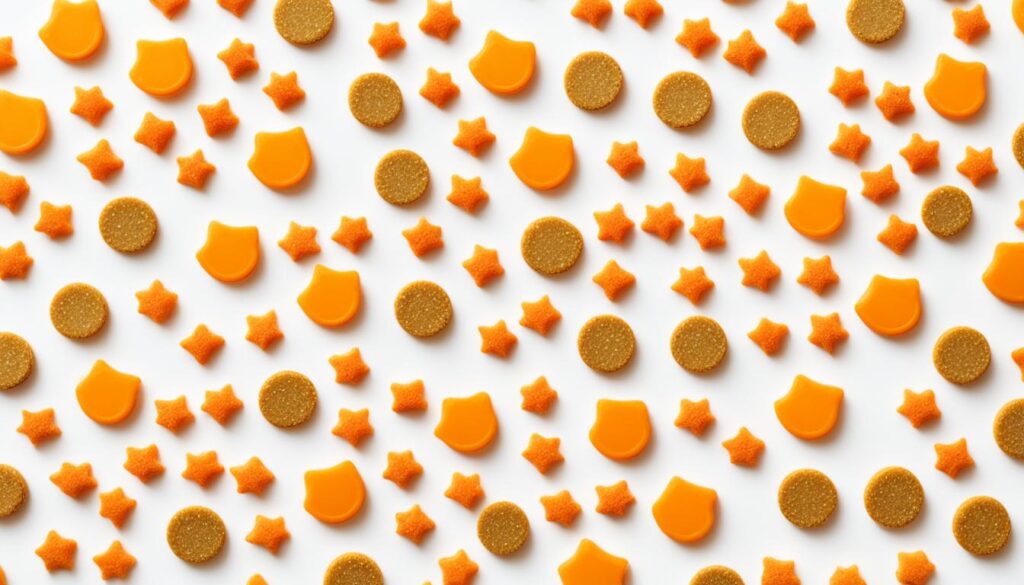
There are many flavors and textures of cat treats. This helps even choosy cats find something they like. They range from crunchy to soft, but all are nutritious.
Nutrient-Dense Foods
For a more natural option, give your cat plain, cooked meat or fish. Meats like chicken or turkey provide important nutrients. They support your cat’s health.
When trying new treats, do it slowly and not too much at once. This helps avoid stomach problems or gaining too much weight. Always talk to your vet for the best advice.
| Treat Type | Nutritional Value | Benefits |
|---|---|---|
| Commercial Cat Treats | High in protein, low in calories | Specifically formulated for feline dietary needs |
| Cooked Lean Meat or Fish | Rich in protein, essential amino acids | Natural source of nutrients for cats |
Consulting with a Veterinarian
For feline nutrition and feeding guidelines for felines, talking to a vet is key. This is especially true if you’re thinking about giving your cat human foods like bread. Vets know a lot about pet health. They can give you advice just for your cat to keep it healthy and happy.
Discussing Dietary Needs
Vets look at your cat’s age, breed, and health to figure out the best foods. They’ll help you find the right mix of proteins, fats, and more your cat needs. This is crucial for your cat’s health and growth. Talking openly with your vet ensures your cat gets the right food, depending on its needs.
Addressing Potential Health Concerns
If your cat has health issues or can’t eat certain foods, talking to a vet is a must. Some illnesses like diabetes or kidney problems change what your cat can eat. Vets can suggest the best food and treats to keep your cat healthy. They will consider the big picture of your cat’s pet health.
Getting advice from a vet makes sure your cat’s diet is good for them. This boosts feline nutrition and keeps your cat healthy for a long time.
| Benefit | Explanation |
|---|---|
| Personalized Advice | Veterinarians can provide tailored recommendations based on your cat’s age, breed, and overall health condition. |
| Dietary Requirements | They can guide you on the ideal balance of nutrients essential for your cat’s growth, maintenance, or specific life stage. |
| Health Concerns | Vets can address any existing medical conditions or dietary restrictions, recommending appropriate cat food formulations or safe treat options. |
| Optimal Nutrition | By following professional guidance, you can ensure your cat receives a well-balanced, nutritious diet, promoting optimal feline nutrition and lifelong well-being. |
Responsible Pet Ownership
Being a responsible pet owner means you must learn a lot about your cat’s diet. For cats, eating right is very important because they’re animals that need meat. However, bread does not supply all the nutrients they need, so it is not a good food for them.
Educating Yourself on Pet Nutrition
Knowing what your cat should eat is key to keeping them healthy. Cats should not eat a lot of high-carb foods like bread. These foods can make cats overweight and cause tummy troubles. They’re just not made to eat too many carbs.
Providing a Balanced Diet
It’s crucial to feed your cat a balanced diet that meets their needs. Commercial cat food is a good choice as it’s made to be nutritious. Adding some fresh fruits and veggies can also help get them extra vitamins. But always remember, there are foods like garlic and onions that are bad for cats. They can make them sick, so avoid them.
If you keep learning and follow advice from professionals, you’re doing a great job as a pet owner. Your cat will be happy, healthy, and live a long time.
Moderation is Key
Cats need a diet full of animal proteins and fats as obligate carnivores. Bread doesn’t offer the essential nutrients for them. But, giving a small piece of plain bread now and then, in moderation, won’t hurt them.
Occasional Treats and Their Role
Avoid giving cats more than 10% of their daily calories as treats. Bread is fine once in a while. But, don’t let it become a big part of their diet. They should mostly eat high-quality cat food.
Maintaining a Healthy Weight
Cats can get overweight from too much bread or carbs. This can cause health problems like diabetes. Always watch how much your cat eats. Make sure they stay at a healthy weight.
Letting your cat have bread sometimes is okay. But, their main diet should fit their needs as a cat. Always feed them well and follow good feeding guidelines for felines.
Conclusion
Cats can eat small amounts of plain bread occasionally. However, it shouldn’t be part of their daily cat food diet. Bread doesn’t have the right nutrients for cats. It can cause them to gain weight, have tummy troubles, and maybe health issues if they eat too much. It’s important as a cat owner to give your cats complete cat food that meets their diet needs. Remember, small amounts of human food like bread are okay as a treat.
Eating a small amount of plain, baked bread every so often is not bad for cats right away. But, bread has a lot of carbs and is low on the nutrients cats need. Too much bread can make cats gain weight and feel sick. It’s surprising, but one slice of bread has a lot of calories for a cat.
Taking good care of your cat means giving them the right cat food that meets their needs. Be careful with human foods including bread. Always ask a vet for advice on how to feed your cat well. They can help with a diet that keeps your cat healthy and happy.
FAQ
Can cats eat bread?
Why is bread not suitable for cats?
Is raw bread dough dangerous for cats?
Are there any toppings or additives in bread that should be avoided for cats?
What are better alternatives to bread for cats?
Should I consult a veterinarian before feeding my cat bread?
Can cats have bread as an occasional treat?
As an Amazon Associate I earn from qualifying purchases.
